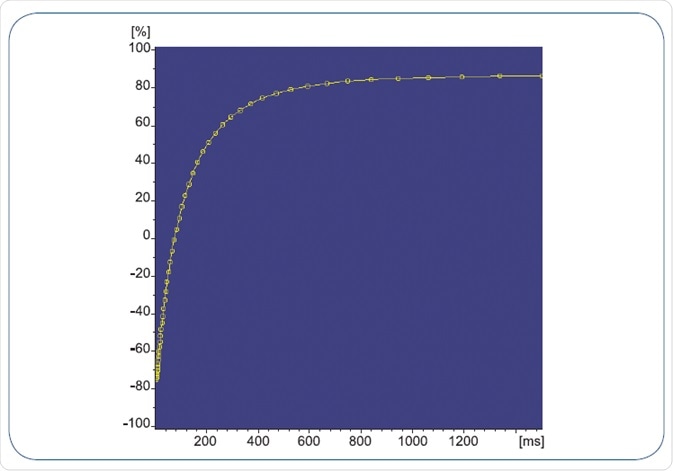
The minispec Contrast Agent Analyzer is typically used to characterize and confirm the relaxation properties of pharmaceuticals called “contrast agents” for Magnetic Resonance Imaging (MRI). The system has been specifically designed to analyze the effect of pharmaceuticals (“MRI contrast agents”) on the NMR relaxation of fat or water protons
- Operates all common pulse sequences for T1, T2 relaxation time analysis, at the touch of a button
- Win expensive MRI time
- Cryogen-free permanent magnet
- Easy siting, benchtop, no high and radio frequency shielding required
- Attractive price when compared to MRI systems
- Easy sample handling and measurement
- Only a small amount of costly contrast agent needed for characterization
Contrast agents are used to improve the contrast in magnetic resonance images between tissues that would generally be hard to distinguish. These include the soft tissue of the digestive, lymphatic, central nervous and cardiovascular systems as well as lung, liver and breast.
In order to design an effective contrast agent, conflicting MRI and pharmaceutical properties have to be met at once: while metal ions like Gd3+ and Mn2+ may result in excellent contrast enhancement, they still need to be chelated as the concentrations of the ‘naked ions‘ applied are quite poisonous.
Here, the minispec mq-series of bench-top NMR instruments play an important role in defining and validating the characteristics of contrast agents. The task involves examining the T1 and T2 relaxation time shortening of fat and water protons by contrast agents. It is these fat and water protons that mainly contribute to the MR image.

Bruker is the only vendor offering 40 and 60 MHz systems for contrast agent research.

Figure shows T1 analysis performed at 60 MHz using the minispec system.
A contrast agent will always speed up the relaxation resulting in a negative or a positive contrast enhancement. Iron salts, manganese chelates and Gadolinium are examples of contrast agents that lead to a T1 signal enhancement. The T2 signal has been reduced using barium sulphate, superparamagnetic iron particles (SPIO), clay and air.
While clinical MRI systems can perform the measurements, MRI time is relatively valuable and expensive for clinical investigations. For such relaxation studies, the compact minispec Contrast Agent Analyzer provides the ideal solution as it gives systems the same magnetic field strength (for example, 0.5 T, 1.0 T and 1.5 T) like clinical MRI systems.
The minispec Contrast Agent Analyzer is an advanced NMR instrument, yet it is simple to operate. It is used by many researchers for routine analysis as it offers a performance advantage due to faster setup and easy single button operation, triggering data processing, acquisition and reporting. For unattended operation, the minispec can be completely automated with an autosampler.
Bruker is the only company that provides table-top 60 and 40 MHz systems intended for contrast agent analyzes. The combination of Bruker’s magnet systems, which are available between 7.5 and 60 MHz, and additional accessories like sample temperature control systems allows complete characterization of the designated contrast agent.
Configuration of Multiple Magnets
Since relaxation times are field dependent, Contrast Agent Research requires analyzing the relaxation times at different field strengths. Bruker therefore provides a solution that is both dedicated and cost effective.
Contrast Agent Analyzers:
- mq7.5 - for measurement of relaxation time parameters at 0.17 T
- mq10 - for measurement of relaxation time parameters at 0.23 T
- mq20 - for relaxation time analyzes near the field of a 0.5 T Clinical MRI system
- mq40 - for relaxation time analyzes near the field of a 1.0 T Clinical MRI system
- mq60 - for relaxation time analyzes near the field of a 1.5 T Clinical MRI system
The temperature of the magnet is generally set to 37 °C for contrast agent analysis, but variable temperature probes are also supplied.
Specifications
Console with Broadband RF electronics
- Modulator: 0°, 90°, 180° and 270° RF phase channels with an accuracy better than 0.2°
- Measuring frequency: 2 to 65 MHz
- Pulse Programmer: 12 pulse channels, resolution 20 nsec; digitizer: 12-bit, 32K points per single shot
- Transmitter: maximum power 300 Watts, linear power attenuation
- Receiver: digital phase sensitive detection through quadrature detection; digital and analog filters
Magnet unit
Fields available: 0.17 T, 0.23 T, 0.47 T, 0.94 T and 1.41 T
Probe temperature options
- Fixed Temperature: A magnet heating system regulates sample chamber temperature at a temperature set between 35 and 45 °C
- Variable Sample Temperature, - 5 to + 65 °C (mq20), + 5 to + 50 °C (mq40, mq60)
- Information about a wider temperature range on request
System requirements
- System weight: ~ 120 kg based on magnetic field
- Footprint: 75 x 65 cm (WxD)
- Humidity: 20 to 80%, non-condensing
- Operating temperature: 18 °C minutes, 28 °C maximum
- Frequency range: 50 to 60 Hz
- Voltage range: 100 to 240 VAC
Options
- Automation: Autosampler for unattended operation for over 100 prepared samples. Barcode reader also available for sample tracking.
About Bruker BioSpin - NMR, EPR and Imaging

Bruker BioSpin offers the world's most comprehensive range of NMR and EPR spectroscopy and preclinical research tools. Bruker BioSpin develops, manufactures and supplies technology to research establishments, commercial enterprises and multi-national corporations across countless industries and fields of expertise.
Sponsored Content Policy: News-Medical.net publishes articles and related content that may be derived from sources where we have existing commercial relationships, provided such content adds value to the core editorial ethos of News-Medical.Net which is to educate and inform site visitors interested in medical research, science, medical devices and treatments.